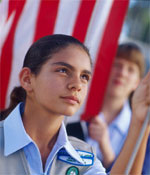Flag Ceremonies A flag ceremony is a way of showing love and respect for one's country. Flag ceremonies may be used for: Flag ceremonies may take place in meeting rooms, in outdoor settings, in large auditoriums, on stage, even on horseback. All flag ceremonies share one thing in common—respect for the flag. Flag Ceremony Guidelines Keep it simple. Emphasis should be on respect for the flag rather than on the commands or techniques. Ask these questions when planning: Terms Used in a Flag Ceremony The color bearer (or flag bearer) is the person who carries the flag. There is one color bearer for each flag used in the ceremony. The color guard is a team that guards the flags. Any even number of guards may be used, but usually four or six girls are sufficient. The Girl Scout in-charge (or caller) is a designated Girl Scout who announces or calls each part of the ceremony. Possible Commands for a Flag Ceremony "Girl Scouts, attention." Used to announce that the flag ceremony is to begin. "Color guard advance." This signals the color guard to advance with the flags, or advance to pick up the flags. "Color Guard, post the colors." This directs the color guard to place the flag in flag standards, or to attach the grommets to a flag pole rope. "Color guard, honor your flag." The color guard salutes the American flag. "Please join us in saying the Pledge of Allegiance." (Followed by an appropriate song, quotation or poem, if so desired.) OR "Color guard, honor your flag." The color guard salutes the American flag. "Color guard, retire the colors." This asks the color guard to remove the flag from standards, or to lower the flag, detach from the rope, and fold prior to being dismissed. "Color guard, dismissed." The color guard leaves in formation, with or without the flag. "Girl Scouts dismissed." Girls may leave in formation or be at ease where they have been standing. Handling the American Flag The display of the American Flag is governed by law to ensure that it will be treated with the respect due the flag of a great nation. This is known as the Flag Code. Some of the rules most useful for Girl Scouts are: Retiring a Worn American Flag Retiring an American Flag is a special ceremony that ends with burning the flag and disposing of the ashes in a respectful manner. For further information, check with Let's Celebrate! Girl Scout Ceremonies or your council training or program staff. * From the U.S. Flag Code.
Honoring the American Flag![]()
